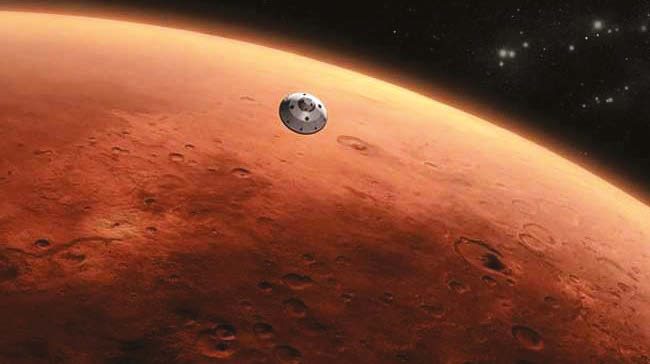
WASHINGTON (TIP): Nasa‘s Curiosity rover has found more evidence of water on ancient Mars during a recent pit stop along the way towards a huge Red Planet mountain. The one-tonne Curiosity rover resumed a trek of many months toward its mountain-slope destination, Mount Sharp. The rover used instruments on its arm to inspect rocks at its first way-point along the route inside Gale Crater. The location, originally chosen on the basis of images taken from Nasa’s Mars Reconnaissance Orbiter, paid off with investigation of targets that bear evidence of ancient wet environments, the US space agency said. “We examined pebbly sandstone deposited by water flowing over the surface, and veins or fractures in the rock,” said Dawn Sumner of University of California, Davis.
“We know the veins are younger than the sandstone because they cut through it, but they appear to be filled with grains like the sandstone,” said Sumner. This Waypoint 1 site at an outcrop called “Darwin” is the first of up to five waypoint stops planned along the route of about 8.6 kilometers between the “Glenelg” area, where Curiosity worked for the first half of 2013, and an entry point to the lower slope of Mount Sharp, the mission’s main destination. It is about one-fifth of the way along the route. The rover departed Waypoint 1 on September 22 with a westward drive of about 22.8 meters. Curiosity’s science team planned the waypoints to collect information about the geology between Glenelg and Mount Sharp. Researchers want to understand relationships between what the mission already discovered at Glenelg and what it may find in the multiple layers of Mount Sharp.
Analysis of drilled samples from veined “Yellowknife Bay” rocks in the Glenelg area provided evidence for a past lakebed environment with conditions favorable for microbial life. That means the mission has fulfilled its principal science goal, researchers said. “We want to understand the history of water in Gale Crater,” Sumner said. “Did the water flow that deposited the pebbly sandstone at Waypoint 1 occur at about the same time as the water flow at Yellowknife Bay? If the same fluid flow produced the veins here and the veins at Yellowknife Bay, you would expect the veins to have the same composition,” Sumner said





Be the first to comment